April 13, 2022
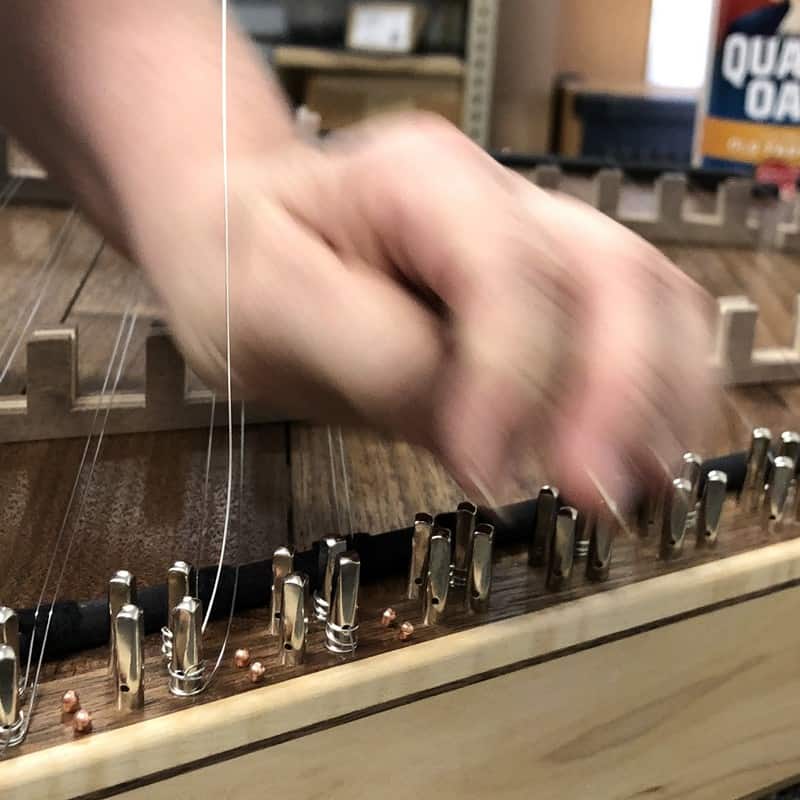
By Nicolette Foss
Not knowing what you don’t know is the hardest part of being a newbie. So you grip your poor hammers for dear life as you hunch over the dulcimer for odd hours, trying to decode “How to play the hammered dulcimer” YouTube videos. They may as well be in another language!
At this point are you even having fun anymore? You might just be reinforcing bad habits that will be harder to kick later on. That is why we polled the Hammered Dulcimer Players group to find out what habits they wish they had known to avoid when they were beginners.
We tallied up the answers and have presented them here to hopefully help you make good progress as you learn to play the hammered dulcimer.
10 Common Hammered Dulcimer Beginner’s Bad Habits
1. Relying on Note Strips
With the vast amount of strings running across a hammered dulcimer, it can be difficult to remember which notes are which. Note strips are little paper strips placed underneath the strings, signifying what notes they are. While this may be helpful to learn the notes in the beginning, using them long-term can become a crutch.
Hammered dulcimer player and instructor Chris Collins had this to say about note strips:
“Focus on the bridge and bridge marks not on the strings, and worse not on note strips. Those note strips slow down learning, because you are focused on the wrong things. Your eyes focus in the wrong place, it obscures the repeating patterns that make up the scales, chords and intervals. Playing by bridge marks means you can easily transpose on the fly, find harmony notes easily, and shift octaves with ease. Playing that way, ultimately develops your ear because once the patterns are learned you can start focusing on ear training, recognizing common note sequences and intervals.”
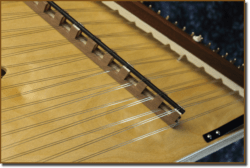
Instructor Sarah Garland also agreed that bridge markers were the way to go when it comes to getting familiar with the dulcimer’s lay of the land. She had a great suggestion:
“I teach beginners to first memorize just the marked courses on the right side of the treble bridge, and I give them a mnemonic to help remember (Dulcimer Groups Create Fun for a 12/11; All Dulcimer Groups Create Fun for a 16/15). Then it’s easy to extend to the left treble and bass, while also emphasizing where octaves are: the pattern just shifts by one marked course, and they only have to remember one new letter for each of those. Then we can fill in the notes between the marked courses, which is mostly just counting up the letters — the only tricky thing for beginners who don’t already have any music knowledge is knowing which notes are sharped.”
2. Relying on Sheet Music

A lot of hammered dulcimer players previously started their musical journey by playing other instruments. You may have been in a band, or sat at a piano learning from sheet music. However, when it comes to sheet music for the hammered dulcimer, this too can become a crutch if you start to rely on it.
But not only that, it can be very difficult to play along with someone else while reading music. You aren’t able to stare at the sheet music and your hands at the same time because you’ll lose your place. Some advanced players can actually do this, but most can’t.
Instead, try to memorize the tune without relying too heavily on the sheet music. First, map out the tune on your instrument. Then practice it slowly to make sure you are playing it correctly, and once it is hard-wired into your memory, you can easily pick up speed to play it more confidently.
Reading sheet music gives you accuracy because you can see exactly how the tune is played. But training your ear to listen for notes will allow you to pick up new tunes easier, which is a valuable skill in the middle of a jam session. Being flexible in this way allows for more improvisation, creativity, and of course more fun.
Try to learn to do both if you can; it is well worth it!
3. Favoring Your Dominant Hand
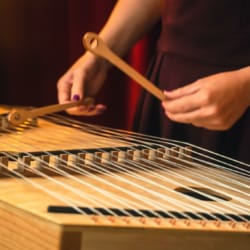
Courtesy of the Lady Victoria
If your dominant hand gets more use, the non-dominant hand will be weaker and you will come to rely on it less. We suggest that you work on strengthening the non-dominant hand to achieve a more cohesive balance between the two. Using both hands well will allow you to play better, and learn quicker over time.
To challenge the non-dominant hand, try learning the melody with it first. Put your dominant hand behind your back to keep it from interfering. When you’ve gotten that down, play the melody with your dominant hand so that both hands will be able to play the notes interchangeably and with equal emphasis. Yes, we know this may be easier said than done!
That being said, it is important to recognize that we all have varying abilities. For instance, you may be seriously right-handed or left-handed. If after some practice you find that one hand is significantly more dominant than the other, try this instead:
Use your dominant hand when it comes to rhythmic patterns. Arrange your songs so your dominant hand is on the downbeat, which will allow the accents to fall in the right place. This allows you to find the best flow that works for you. Eventually, your non-dominant hand will find a way to take the lead sometimes.
4. Neglecting to Tune Your Hammered Dulcimer
In the beginning, you may grumble at the chore of tuning your dulcimer. But you will learn over time that keeping it in tune will not only make it sound better, it will help you familiarize yourself with what the notes should sound like. When you get used to hearing your dulcimer out of tune, your ears get used to the wrong notes, and this can impede your progress.
Learn to enjoy the process of maintenance of your instrument, and it will never feel like a chore! We like to say the name of each note as it is being tuned, to stay present, focused, and help you understand the layout of your dulcimer quicker.
5. Learning on Your Own
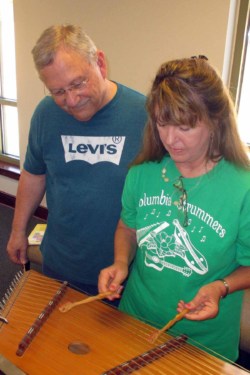
Instructor Jess Dickinson gives a hammered dulcimer lesson to his student
YouTube instruction videos, sheet music, and playing solo can be a bumpy ride on the road of progress. Finding a teacher can make for a much smoother journey. Hammered dulcimer teachers are great at:
- Helping you avoid bad habits: Bad habits can hold you back from progressing and achieving the high-level playing you are shooting for. An example of one common bad habit would be holding your hammers in a death grip. A good instructor will show you the proper way to hold the hammers.
- Helping you stay motivated and progressing: Having a teacher can also keep you motivated to continue improving every week because you have someone to be accountable to. He or she will have tons of suggestions for fun songs to learn and opportunities to expand your horizons in the folk music world.
- Adding more joy to the process: The hammered dulcimer can feel intimidating in the beginning. Learning from an instructor whose company you genuinely enjoy will make the process seem more playful than task-oriented. And when you’re having fun, you are more likely to stick with it and keep improving!
These days it is so easy to connect on Skype or Zoom with someone who is versed in all things hammered dulcimer. There are plenty of instructors to choose from all over the world!
Try out a lesson or two to see if the instructor resonates with you. If their teaching style does not jibe with your learning style, do not feel obligated to continue. Dreading a lesson can impede your desire to learn.
Find a good instructor in our helpful links page. If you don’t see your favorite instructor listed (or if you are one yourself), please leave us a comment below so we can add them to the list!
6. Not Practicing Enough
Learning any musical instrument, language, or skill takes time. And if you don’t use it, you lose it, as they say. This is why practice is so important.
We recommend practicing once a day to keep what you have learned fresh in your mind. Even if it is only for a quick 5 to 10 minute session, it will make a huge difference in your improvement over time.
Spaced repetition is the key to remembering things long-term. If you take a look at the The Forgetting Curve image, you can see that the more often you practice something in the first few days of learning, the more likely it will stick in your brain long-term.
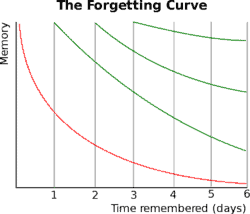
Try learning a new chord or song you want to work on using the 1-2-3-7 method. This means practicing it today (Day 1), then again tomorrow (Day 2), then the day after tomorrow (Day 3), and then a week from your first practice (Day 7).
With this method, you will learn much more quickly and efficiently, instead of having to re-learn things over and over again. However, if sticking to the routine starts to feel like a chore, give yourself a break until you feel the urge to get back into it again. When you have a natural curiosity to learn and grow, you’ll progress quicker and then you’ll be jamming in no time!
7. Not Learning Chords
We think that chords should be one of the first things you learn. If you do not take the time to learn chords, you will just be playing the melody. This can seriously limit your repertoire.
Knowing chords and how they work together will help you understand the structure of your tunes. It also helps you find harmony notes to go along with the melody and spice up the tune. Knowing chords also lets you play back up when someone else is playing the melody, and allows you to harmonize with someone else. So, try to learn just a little bit of music theory if you can. You’ll find it engrossing and fun!
A teacher can help you practice and learn chords. Or you can learn them from YouTube videos or books. Instructor Jess Dickinson’s book, The Essential Hammered Dulcimer Basic Instruction Manual is very helpful when learning chords. Here is Jess teaching beginner chords:
8. Overthinking it

If you are getting lost in the intimidating terminology we are throwing at you, simply relax. Forget it! These things come with time and experience. The process will unfold naturally.
The more pressure you put on yourself, the less likely you will continue to persevere in your learning. When done the right way, playing music should actually help combat stress and tension from your daily life!
If you find yourself tense and frustrated about hitting the wrong note, take a break. Stretch your hands and shoulders to prevent yourself from slumping forward. Breathe. It is ok to make mistakes! Even long-time players hit the occasional wrong note.
9. Playing Alone
We always say the hammered dulcimer is a social animal. It needs friends! As a newbie, you may feel a bit shy about showcasing your new hammered dulcimer skills to the world. But there is no need to be bashful; many players in the hammered dulcimer community are very kind, welcoming, and eager to share their hard-earned knowledge.
Find some people to play with; it doesn’t need to be other hammered dulcimer players. Find anybody that is getting together to make music: Old time jams, bluegrass, church, death metal, or whatever suits your fancy. You will make the fastest progress if you get out there and play with others. You don’t need to know much, just have your dulcimer in tune and go!
If possible, play in a jam session or at your local festivals as often as you can. Not only will it speed up your progress, you will learn new songs, and avoid many of these common pitfalls and mistakes. Oh, and you just might have a mighty fine time. 🙂
10. Not Having Fun

We play music for the good of our souls. Music is a language. It is communication from one soul to another, bypassing the intellect. It is the most universal kind of communication and can even work between species (Chris’ cat Mactavish loved the banjo, and pictured: Pete learning to play dulcimer).
When you sit down to play, it should be fun! When we encourage you to practice every day, this may sound like work. But it isn’t work at all, it is a sort of a game, which is why we say that we “play” music. Because it is just that, play!
We All Learn In Our Own Rhythm
So, how’d you do? Did you identify any possible bad habits you might be picking up?
Keep in mind that even though these are common pitfalls experienced players have identified, they may not apply to you. We all learn in our own rhythm. You are welcome to heed these time-tested trials and tribulations, but ultimately you decide what is right for your learning path.
We wish you a beautiful, fruitful, and enjoyable hammered dulcimer journey.
Comment below any bad habits you’ve found yourself picking up, or suggestions that might be helpful for other hammered dulcimer beginners.
 About the author: In her childhood, Nicolette Foss could be found underneath piles of sawdust in her father’s hammered dulcimer workshop. She helped with odds and ends in the business, attended folk music festivals, and learned the importance of hard work. These days, you can find her belly dancing to instrumental Arabic music, learning the Serbian language, making short films with friends, and cuddling her cat Georgie. If you’d like to hire Nicolette for content writing or copywriting work, contact her at: nicolettelady@protonmail.com
About the author: In her childhood, Nicolette Foss could be found underneath piles of sawdust in her father’s hammered dulcimer workshop. She helped with odds and ends in the business, attended folk music festivals, and learned the importance of hard work. These days, you can find her belly dancing to instrumental Arabic music, learning the Serbian language, making short films with friends, and cuddling her cat Georgie. If you’d like to hire Nicolette for content writing or copywriting work, contact her at: nicolettelady@protonmail.com
Image credits: “Overthinking” by peter.slavik is marked with CC BY 2.0
Tags: hammered dulcimer beginners, hammered dulcimer mistakes, learning hammered dulcimer
8 Comments
-
Nicely done
-
I think you did great in covering top 10 Habits to Break!!
-
While I don’t totally agree with a few of the details within a couple of your Habits, you have made a comprehensive list that beginners should consider and heed. Thanks for your work!
-
“NOT HAVING FUN” is probably the biggest mistake IMHO. When it become work, its hard to push on
-
I’ve only been playing for about 45 years. Where were you when I started?
Good recomendations for starting out!
-
I heard early on that I would not have to force myself to practice. I would have to force myself to STOP practicing. And I found that to be true.
-
A lot of good info. Since I am left handed living in a right handed world it was easy for me to use both hands almost immediately. Back in the late 80’s the hammered dulcimer group was sort of an underground thing. My dulcimer maker introduced me to the local group. I learned a few tunes and got up the courage to attend a get together. When it was my turn to choose the tune. I said do know? No one said anything. So I started playing and no one joined in. I was so freaked I could hardly keep playing but made it through the tune 3 times and got lots of compliments. In all the years and people I have met in the dulcimer world I only came across one obnoxious egotistical female. Hammered dulcimer folks are the best 😍
-
I’m glad you wrote this article as I’m very new at this and I’m thinking of learning it. While I agree with most of it, some things I’m struggling with…(and yes, I am an overthinker). I already play other instruments (mostly guitar) and I’m having trouble making some comparisons. While the notes of the chords are true, you never seem to really play them together as one chord. It’s more of an arpeggio thing. That, and I always had trouble playing with other guitar players until I could play at a decent level and make a contribution. Thanks again for your help!
